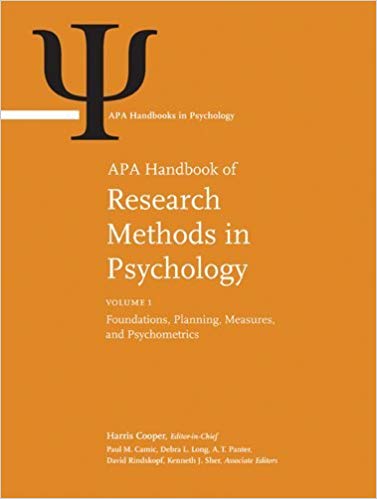The three-volume APA Handbook of Research Methods in Psychology features descriptions of many techniques that psychologists and others have developed to help them pursue a shared understanding of why humans think, feel, and behave the way they do.
At the broadest level, when choosing a method, researchers make decisions about what data or measurement techniques will best capture the thoughts, feelings, and behaviors that interest them; what research design best fits the question that they want to answer; and what strategies for data analysis best match the characteristics of their design and measurements. The simplest choice for organizing the presentation of material is the temporal sequence in which they will make these decisions.
The earliest chapters in the handbook address the broadest questions related to research designs. These involve both (a) which research designs are most appropriate for which question; and (b) how to think about the ethicality and feasibility of the designs that address the question and the measures available.
Next, handbook chapters describe the types of data that psychologists most often collect and how to determine whether the measurement techniques are the best ones for the research purpose.
Later, the chapters return to issues of research design and present a panoply of options, further divided along more nuanced distinctions in their objectives. Chapters on techniques for data analysis follow, again with special attention to the fit between design, measurement, and analysis.
Finally, issues and choices to be considered when writing up research to share with the community of psychologists are discussed in the handbook's concluding chapters.
چکیده فارسی
دستنامه سه جلدی APA هندبوک روشهای تحقیق در روانشناسی شرح بسیاری از تکنیکهایی را ارائه میکند که روانشناسان و دیگران برای کمک به درک مشترک از چرایی تفکر، احساس و رفتار انسانها توسعه دادهاند. آنها انجام می دهند.
در گستردهترین سطح، هنگام انتخاب یک روش، محققان تصمیم میگیرند که چه دادهها یا تکنیکهای اندازهگیری افکار، احساسات و رفتارهای مورد علاقهشان را به بهترین شکل به تصویر میکشند. چه طرح تحقیقی با سؤالی که می خواهند به آن پاسخ دهند مناسب است. و اینکه چه استراتژی هایی برای تجزیه و تحلیل داده ها به بهترین وجه با ویژگی های طراحی و اندازه گیری آنها مطابقت دارد. ساده ترین انتخاب برای سازماندهی ارائه مطالب، توالی زمانی است که در آن آنها این تصمیمات را می گیرند.
اولین فصلهای کتاب راهنما به گستردهترین سؤالات مربوط به طرحهای پژوهشی میپردازد. اینها شامل هر دو می شود (الف) اینکه کدام طرح های تحقیقاتی برای کدام سؤال مناسب هستند. و (ب) چگونه در مورد اخلاقی بودن و امکان سنجی طرح هایی که به این سوال و اقدامات موجود می پردازند فکر کنیم.
بعد، فصلهای کتاب راهنما انواع دادههایی را که روانشناسان اغلب جمعآوری میکنند و نحوه تعیین اینکه آیا تکنیکهای اندازهگیری بهترین روشها برای هدف تحقیق هستند یا نه، شرح میدهند.
بعداً، فصلها به مسائل طراحی تحقیق بازمیگردند و مجموعهای از گزینهها را ارائه میکنند که بیشتر در امتداد تمایزات ظریفتر در اهدافشان تقسیم میشوند. فصلهای مربوط به تکنیکهای تجزیه و تحلیل دادهها، مجدداً با توجه ویژه به تناسب بین طراحی، اندازهگیری و تجزیه و تحلیل، در ادامه میآیند.
در نهایت، مسائل و انتخابهایی که باید هنگام نوشتن تحقیق برای به اشتراک گذاشتن با جامعه روانشناسان در نظر گرفته شوند، در فصلهای پایانی کتاب راهنما مورد بحث قرار میگیرند.
ادامه ...
بستن ...










